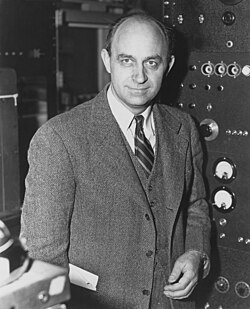Enrico Fermi
Enrico Fernando Fermi (September 29, 1901 — November 28, 1954) was an Italian-American physicist who worked on the first nuclear reactor and helped make quantum theory. He also was important to particle physics, and statistical mechanics. Fermi won the Nobel Prize in Physics in 1938 for his work on induced radioactivity. He built the world's first nuclear reactor. Fermi also worked on the Manhattan Project.[1] Fermi was one of the greatest scientists of the 20th century.[1]
Enrico Fernando Fermi | |
|---|---|
 Enrico Fermi in 1940s | |
| Born | September 29, 1901 |
| Died | November 28, 1954 (aged 53) |
| Nationality | Italian-American |
| Occupation | physicist |
| Known for | Nobel Prize in Physics, 1938 |
Early life change
Fermi was born in Rome and went to a local grammar school. He was very good at maths and science and won a prize from Scuola Normale Superiore of Pisa.[2] He went to the University of Pisa where he studied physics. In 1923 he was given a scholarship from the Italian government and went to Göttingen for more study. He was given a Rockefeller scholarship in 1924 and studied in Leyden. He came back to Italy at the end of 1924 and became Lecturer in Mathematical Physics and Mechanics at the University of Florence.
Scientist in Italy change
In 1926, Fermi discovered the statistical laws, now called Fermi statistics.[2] These laws explain the actions of the particles which are subject to the Pauli exclusion principle, which are now called fermions. These are different to the particles called bosons which are explained by Bose-Einstein statistics. In 1927 he became Professor of Theoretical Physics at the University of Rome.[2] He spent time studying electrodynamics, and began to closely look at the atomic nucleus. In 1934, using discoveries made by Wolfgang Pauli, Frédéric Joliot, Irène Joliot-Curie, he was able to show changes in almost every element bombarded with neutrons.[2] This led to the discovery of slow neutrons, nuclear fission and making elements that were not in the Periodic Table.
Fermi moved from Italy to the United States after winning the Nobel Prize in Physics in 1938 because Italy’s leader Benito Mussolini was close to Adolf Hitler, and Fermi’s wife and children were Jews.[2]
Scientist in America change
Fermi worked at Columbia University where he studied Nuclear fission, which is to say how atoms break apart and he then moved to Chicago where he built a Nuclear reactor in 1942. Then Dr. Julius Robert Oppenheimer got Fermi to work with him on the Manhattan Project and Fermi helped Oppenheimer and the others to build an Atomic bomb. It was used against Japan at the end of the Second world war.[3]
Fermi expressed his concerns about the dangers of nuclear energy at one of the meetings of the University of Chicago before the end of the WWII.[3]
Fermi Paradox change
In the 1950s, Fermi and Dr. Edward Teller, Dr. Herbert York and Dr. Emil Konopinski talked about how according to statistics it makes no sense for Extraterrestrial life not to exist. So Fermi asked “Where is everybody?” This is called the Fermi paradox, the idea that if aliens exist then we should have seen them but it doesn’t make sense for aliens not to exist either. Scientists today still wonder and argue about what the answer to the Fermi Paradox is.
References change
- ↑ "Enrico Fermis and the First Slef-Sustaining Nuclear Reaction". R & D Accomplishments. U.S. Department of Energy. Retrieved 2010-02-21.
- ↑ 2.0 2.1 2.2 2.3 "Enrico Fermi – Biography". Nobel Lectures, Physics 1922–1941. Elsevier Publishing Company, Amsterdam. 1965. Retrieved 2010-02-21.
- ↑ Smil, Vaclav (2005). Energy at the Crossroads: Global Perspectives and Uncertainties. MIT Press. p. 29. ISBN 978-0-262-69324-0.